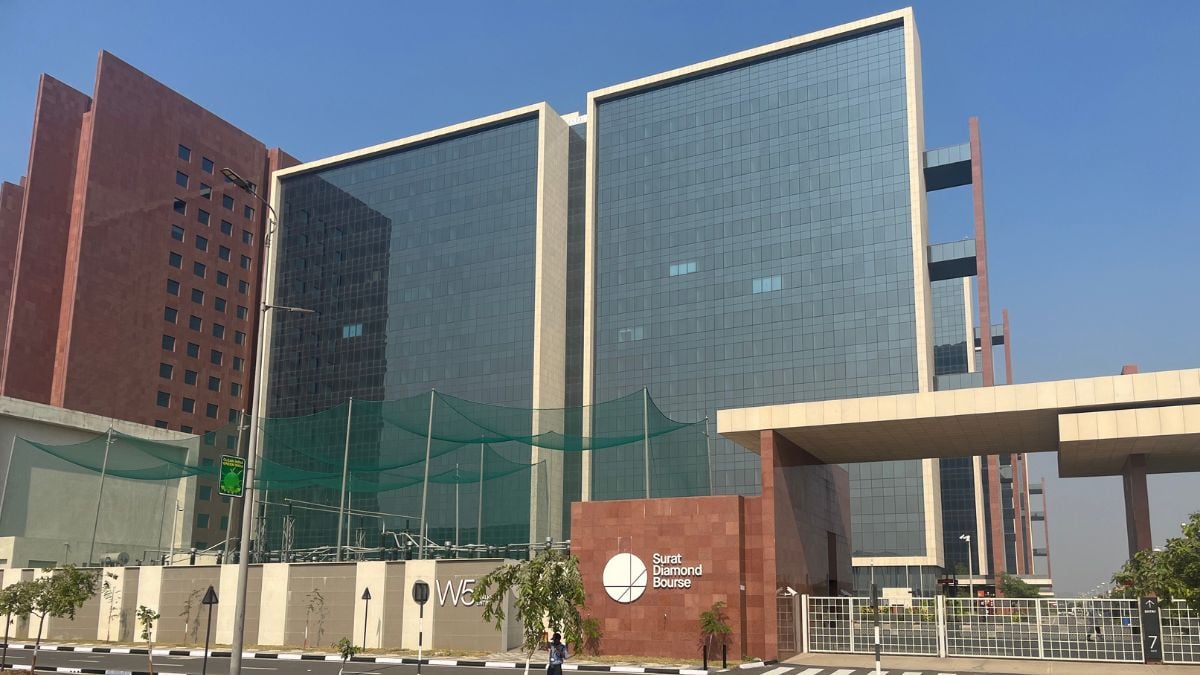This building has quickly transitioned into what many are calling a ‘ghost building’. | FPJ
Surat: The Surat Diamond Bourse, once celebrated as the world’s largest office building, has quickly transitioned into what many are calling a ‘ghost building’. This development comes as a shock, especially after its high-profile inauguration by PM Narendra Modi in December 2023, as it raises questions about the future of the ambitious project that was expected to redefine India’s position in the global diamond trade.
Prime Minister Narendra Modi Lauds Surat Diamond Bourse
July 2023 marked a moment of national pride for India when Prime Minister Narendra Modi responded to a CNN report, lauding the Surat Diamond Bourse as the world’s largest office building, surpassing even the Pentagon in the United States. Constructed with an investment of Rs 3,500 crore, the building boasted over 4,200 diamond offices, a massive customs clearance house, and space for the world’s renowned jewellery brands, among other amenities. Its inauguration by Modi on December 17 was a spectacle of hope and triumph.
Chairman Announces Moving Back To BDB Mumbai
However, within a month, the building’s vast halls remained eerily silent. Vallabhbhai Lakh., chairman of Kiran Gems and the first to initiate operations at the bourse, announced plans to move back to the Bharat Diamond Bourse (BDB) in Mumbai, citing the absence of other comp.es as a critical factor in his decision. This move by Lakh. highlighted a significant oversight in the Surat Diamond Bourse’s planning and execution.
Issues Within BDB Revealed
A closer examination reveals that the fundamental issue lies in the neglect of small traders and brokers, who are the backbone of India’s diamond trade. Unlike the successful model of the Bharat Diamond Bourse (BDB) in Mumbai, which provides two giant trading halls for small-time traders to conduct business free of cost, the Surat Diamond Bourse lacked such provisions. This oversight not only alienated a significant segment of the diamond trading community but also undermined the bourse’s potential as a comprehensive trading hub.
BDB Neglecting Diamond Artisan, Claims
Owner of a De Beers sight holder company asking anonymity said, “Like the diamond artisans, diamond brokers and merchants are the backbone of the diamond industry. You can’t ignore them (diamond brokers) when it comes to smooth functioning of diamond business”
BDB Mumbai: Model Of Inclusive Planning
The Bharat Diamond Bourse in Mumbai’s Bandra Kurla Complex stands as a testament to inclusive planning. By accommodating over 13,000 members of the Mumbai Diamond Merchants Association (MDMA) in a trading hall spread over 20,000 square feet makes business within BDB extremely convenient for the small traders and brokers who are MDMA members.
BDB ensures that small traders and brokers can conduct their business efficiently. These facilities have been crucial in sustaining the vibrancy and dynamism of Mumbai’s diamond trade, a feature starkly missing in the Surat Diamond Bourse.
Dismay In Trading Community Of Surat
The disappointment among the trading community is palpable. Small diamond traders and brokers express their disillusionment with the Surat Diamond Bourse. Their grievances highlight a critical oversight: the failure to integrate the needs and realities of the small traders into the bourse’s design and location. The absence of a trading hall within the bourse and the lack of accessible transportation from key markets like Mahidhapura and Varachha have been significant barriers to its adoption.
Surat Globally Leading State For Diamond Cutting And Polishing
Surat, known as the global leader in diamond cutting and polishing, processes over Rs. 2 lakh crore worth of diamonds annually. The existing diamond markets in Mahidhapura and Varachha have served the industry for decades.
Dimond Broker Expresses Disappointment Over BDB’s Ignorance Towards Trading Community
Diamond broker Kushal Van., operating in Mahidhapura for 15 years, expressed disappointment: “The Surat Diamond Bourse ignored the trading community by failing to include a dedicated trading hall. This is the primary reason for its failure.”
Adding to the concerns, the Bourse’s location, 20 km away from the existing markets, presents logistical challenges for diamond brokers, lacking a reliable public transport system. Jairam Shah, another trader, remarked, “Even with a trading hall, the distance would deter brokers from utilizing the Bourse.”
BDB’s Downfall In Surat
The Surat Diamond Bourse’s struggle to attract occupants and its subsequent decline into a ‘ghost building’ reflect a broader issue of project planning in the diamond trade industry. While ambition and scale can drive progress, the success of such mega-projects hinges on a deep understanding of the industry’s ecosystem and the needs of its smallest participants. The contrast between the thriving Bharat Diamond Bourse and the faltering Surat Diamond Bourse serves as a compelling case study on the importance of inclusive planning and community engagement in the trade industry.
“The tale of the Surat Diamond Bourse is a sobering reminder of the complexities involved in creating infrastructures that serve broad industry objectives” said .ruddha Lidbide, diamond trade analyst. “As the building stands largely empty, stakeholders are left to ponder the lessons learned and the path forward. For India’s diamond trade to flourish, future projects must prioritize inclusivity and practicality over sheer scale and ambition”.
